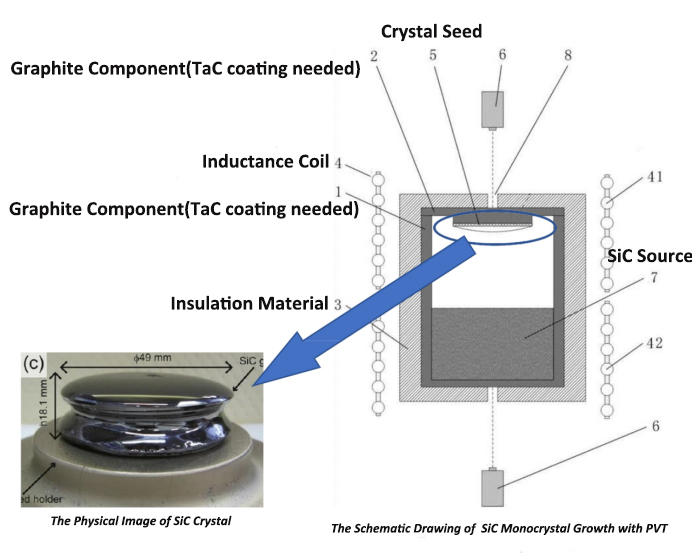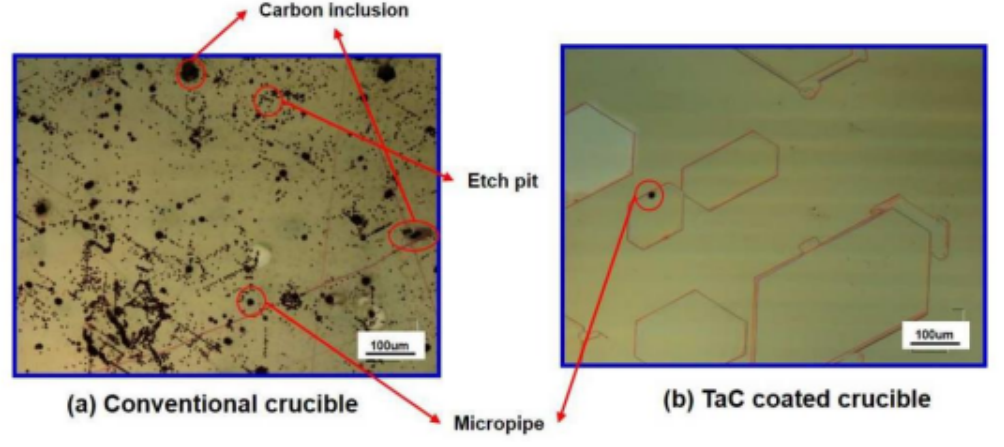
- English
- Español
- Português
- русский
- Français
- 日本語
- Deutsch
- tiếng Việt
- Italiano
- Nederlands
- ภาษาไทย
- Polski
- 한국어
- Svenska
- magyar
- Malay
- বাংলা ভাষার
- Dansk
- Suomi
- हिन्दी
- Pilipino
- Türkçe
- Gaeilge
- العربية
- Indonesia
- Norsk
- تمل
- český
- ελληνικά
- український
- Javanese
- فارسی
- தமிழ்
- తెలుగు
- नेपाली
- Burmese
- български
- ລາວ
- Latine
- Қазақша
- Euskal
- Azərbaycan
- Slovenský jazyk
- Македонски
- Lietuvos
- Eesti Keel
- Română
- Slovenski
- मराठी
- Srpski језик
Core Material for SiC Growth: Tantalum Carbide Coating
2024-06-24
The commonly used method for Silicon Carbide single crystal preparation is the PVT (Physical Vapor Transport) method, where the principle involves placing the raw materials in a high-temperature zone, while the seed crystal is in a relatively low-temperature area. The raw materials at the higher temperature decompose, producing gaseous substances directly without going through a liquid phase. These gaseous substances, driven by the axial temperature gradient, are transported to the seed crystal, where nucleation and growth occur, resulting in the crystallization of Silicon Carbide single crystals. Currently, foreign companies such as Cree, II-VI, SiCrystal, Dow, and domestic companies like Tianyue Advanced, Tianke Heida, and Century Jingxin use this method.
Silicon Carbide has over 200 crystal types, and precise control is required to generate the desired single crystal type (mainly 4H crystal type). According to Tianyue Advanced’s IPO disclosure, the crystal rod yield rates were 41%, 38.57%, 50.73%, and 49.90% from 2018 to H1 2021, while substrate yield rates were 72.61%, 75.15%, 70.44%, and 75.47%, with an overall yield rate of only 37.7% currently. Using the mainstream PVT method as an example, the low yield rate is mainly due to the following difficulties in SiC substrate preparation:
Difficult temperature field control: SiC crystal rods need to be produced at 2500°C, whereas Silicon crystals only require 1500°C, necessitating special single crystal furnaces. Precise temperature control during production poses significant challenges.
Slow production speed: Traditional Silicon material grows at a rate of 300 millimeters per hour, whereas Silicon Carbide single crystals can only grow at 400 micrometers per hour, nearly 800 times slower.
High-quality parameters requirement, difficulty in real-time control of the black box yield rate: Core parameters of SiC wafers include microtube density, dislocation density, resistivity, curvature, surface roughness, etc. During crystal growth, precise control of the Silicon-to-Carbon ratio, growth temperature gradient, crystal growth rate, airflow pressure, etc., is essential to avoid polycrystalline contamination, resulting in unqualified crystals. Real-time observation of crystal growth in the graphite crucible’s black box is not feasible, necessitating precise thermal field control, material matching, and accumulated experience.
Difficulty in crystal diameter expansion: Under the gas-phase transport method, the expansion technology for SiC crystal growth poses significant challenges, with the growth difficulty increasing geometrically as crystal size increases.
Generally low yield rate: The low yield rate comprises two links - (1) Crystal rod yield rate = semiconductor-grade crystal rod output / (semiconductor-grade crystal rod output + non-semiconductor-grade crystal rod output) × 100%; (2) Substrate yield rate = qualified substrate output / (qualified substrate output + unqualified substrate output) × 100%.
To prepare high-quality, high-yield Silicon Carbide substrates, a good heat field material is essential for precise temperature control. The current thermal field crucible kits mainly consist of high-purity graphite structural components, which are used for heating, melting of Carbon powder and Silicon powder, and insulation. Graphite materials have superior specific strength and specific modulus, good resistance to thermal shock and corrosion, etc. However, they have drawbacks such as oxidation in high-temperature oxygen environments, poor resistance to ammonia and scratching, making them unable to meet the increasingly stringent requirements for graphite materials in Silicon Carbide single crystal growth and epitaxial wafer production. Hence, high-temperature coatings like Tantalum Carbide are gaining popularity.
1. Characteristics of Tantalum Carbide Coating
Tantalum Carbide (TaC) ceramic has a high melting point of 3880°C, with high hardness (Mohs hardness of 9-10), significant thermal conductivity (22W·m-1·K−1), high flexural strength (340-400MPa), and a low thermal expansion coefficient (6.6×10−6K−1). It exhibits excellent thermal and chemical stability and outstanding physical properties, with good chemical and mechanical compatibility with graphite, C/C composite materials, etc. Therefore, TaC coatings are widely used in aerospace thermal protection, single crystal growth, energy electronics, medical devices, and other fields.
TaC coating on graphite has better chemical corrosion resistance than bare graphite or SiC-coated graphite, and can be stably used at high temperatures up to 2600°C without reacting with many metallic elements. It is considered the best coating for third-generation semiconductor single crystal growth and wafer etching, significantly improving temperature and impurity control in the process, leading to the production of high-quality Silicon Carbide wafers and related epitaxial wafers. It is especially suitable for MOCVD equipment growth of GaN or AlN single crystals and PVT equipment growth of SiC single crystals, resulting in significantly enhanced crystal quality.

2. Advantages of Tantalum Carbide Coating
Devices The use of Tantalum Carbide (TaC) coatings can solve crystal edge defect issues, improve crystal growth quality, and is one of the core technologies for “fast growth, thick growth, large growth.” Industry research has also shown that TaC-coated graphite crucibles can achieve more uniform heating, providing excellent process control for SiC single crystal growth, thereby significantly reducing the probability of SiC crystal edges forming polycrystals. In addition, TaC-coated graphite crucibles offer two major advantages:
(1) Reduction of SiC defects In the control of SiC single crystal defects, there are typically three important ways, i.e., optimizing growth parameters and using high-quality source materials (such as SiC source powders), and replacing graphite crucibles with TaC-coated graphite crucibles to achieve good crystal quality.

Schematic diagram of conventional graphite crucible (a) and TaC-coated crucible (b)
According to research from Eastern European University in Korea, the primary impurity in SiC crystal growth is nitrogen. TaC-coated graphite crucibles can effectively limit nitrogen incorporation into SiC crystals, thereby reducing the formation of defects such as microtubes, improving crystal quality. Studies have shown that under the same conditions, the carrier concentration in SiC wafers grown in conventional graphite crucibles and TaC-coated crucibles is approximately 4.5×1017/cm and 7.6×1015/cm, respectively.

Comparison of defects in SiC single crystal growth between conventional graphite crucible (a) and TaC-coated crucible (b)
(2) Prolonging the life of graphite crucibles Currently, the cost of SiC crystals remains high, with graphite consumables accounting for about 30% of the costs. The key to reducing graphite consumables costs lies in extending their service life. According to data from a British research team, Tantalum Carbide coatings can extend the service life of graphite components by 30-50%. By using TaC-coated graphite, the cost of SiC crystals can be reduced by 9%-15% through the replacement of TaC-coated graphite alone.
3. Tantalum Carbide Coating Process
The preparation of TaC coatings can be classified into three categories: solid-phase method, liquid-phase method, and gas-phase method. The solid-phase method mainly includes reduction method and compound method; the liquid-phase method includes molten salt method, sol-gel method, slurry-sintering method, plasma spraying method; the gas-phase method includes chemical vapor deposition (CVD), chemical vapor infiltration (CVI), and physical vapor deposition (PVD) methods, etc. Each method has its advantages and drawbacks, with CVD being the most mature and widely used method for preparing TaC coatings. With continuous process improvements, new techniques such as hot wire chemical vapor deposition and ion beam-assisted chemical vapor deposition have been developed.
TaC coating-modified carbon-based materials mainly include graphite, carbon fibers, and carbon/carbon composite materials. Methods for preparing TaC coatings on graphite include plasma spraying, CVD, slurry-sintering, etc.
Advantages of CVD method: The preparation of TaC coatings through CVD is based on tantalum halides (TaX5) as the tantalum source and hydrocarbons (CnHm) as the carbon source. Under specific conditions, these materials decompose into Ta and C, which react to form TaC coatings. CVD can be carried out at lower temperatures, thereby avoiding defects and reduced mechanical properties that may arise during high-temperature coating preparation or treatment. The composition and structure of the coatings can be controlled with CVD, offering high purity, high density, and uniform thickness. More importantly, CVD provides a mature and widely adopted method for preparing high-quality TaC coatings with easily controllable composition and structure.
Key influencing factors in the process include:
(1) Gas flow rates (tantalum source, hydrocarbon gas as carbon source, carrier gas, diluent gas Ar2, reducing gas H2): Changes in gas flow rates significantly affect the temperature, pressure, and gas flow field in the reaction chamber, leading to changes in coating composition, structure, and properties. Increasing Ar flow will slow down coating growth rate and reduce grain size, while the molar mass ratio of TaCl5, H2, and C3H6 influences the coating composition. The molar ratio of H2 to TaCl5 is most suitable at (15-20):1, and the molar ratio of TaCl5 to C3H6 is ideally close to 3:1. Excessive TaCl5 or C3H6 can result in the formation of Ta2C or free Carbon, affecting wafer quality.
(2) Deposition temperature: Higher deposition temperatures lead to faster deposition rates, larger grain sizes, and rougher coatings. Additionally, the decomposition temperatures and rates for hydrocarbons into C and TaCl5 into Ta differ, leading to the easier formation of Ta2C. Temperature has a significant impact on TaC coating-modified carbon material, with higher temperatures increasing deposition rates, grain sizes, changing from spherical to polyhedral shapes. Furthermore, higher temperatures accelerate TaCl5 decomposition, reduce free Carbon, increase internal stress in coatings, and may lead to cracking. However, lower deposition temperatures can reduce coating deposition efficiency, prolong deposition time, and increase raw material costs.
(3) Deposition pressure: Deposition pressure is closely related to the surface free energy of materials and affects the residence time of gases in the reaction chamber, thereby influencing nucleation rate and grain size of coatings. As deposition pressure increases, gas residence time lengthens, allowing reactants more time for nucleation reactions, increasing reaction rates, enlarging grains, and thickening coatings. Conversely, lowering deposition pressure reduces gas residence time, slowing reaction rates, reducing grain size, thinning coatings, but deposition pressure has a minimal impact on crystal structure and composition of coatings.
4. Trends in Tantalum Carbide Coating Development
The thermal expansion coefficient of TaC (6.6×10−6K−1) differs slightly from that of carbon-based materials like graphite, carbon fibers, C/C composite materials, causing single-phase TaC coatings to crack or delaminate easily. To further improve the oxidation resistance, high-temperature mechanical stability, and chemical corrosion resistance of TaC coatings, researchers have conducted studies on composite coatings, solid solution strengthening coatings, gradient coatings, etc.
Composite coatings seal cracks in single coatings by introducing additional coatings into the surface or inner layers of TaC, forming composite coating systems. Solid solution strengthening systems like HfC, ZrC, etc., have the same face-centered cubic structure as TaC, enabling infinite mutual solubility between the two carbides to form a solid solution structure. Hf(Ta)C coatings are crack-free and exhibit good adhesion with C/C composite materials. These coatings offer excellent burn resistance. Gradient coatings refer to coatings with continuous gradient distribution of coating components along their thickness. This structure can reduce internal stress, improve thermal expansion coefficient matching issues, and prevent crack formation.
5. Tantalum Carbide Coating Device Products
According to QYR (Hengzhou Bozhi) statistics and forecasts, the global sales of Tantalum Carbide coatings reached 1.5986 million USD in 2021 (excluding Cree’s self-produced Tantalum Carbide coating device products), indicating that the industry is still in the early stages of development.
(1) Expansion rings and crucibles required for crystal growth: Calculated based on 200 crystal growth furnaces per enterprise, the market share of TaC coating device required by 30 crystal growth companies is approximately 4.7 billion RMB.
(2) TaC trays: Each tray can carry 3 wafers, with a lifespan of 1 month per tray. Every 100 wafers consume one tray. 3 million wafers require 30,000 TaC trays, with each tray having around 20,000 pieces, totaling approximately 6 billion annually.
(3) Other decarbonization scenarios. Approximately 1 billion for high-temperature furnace linings, CVD nozzles, furnace pipes, etc.**




